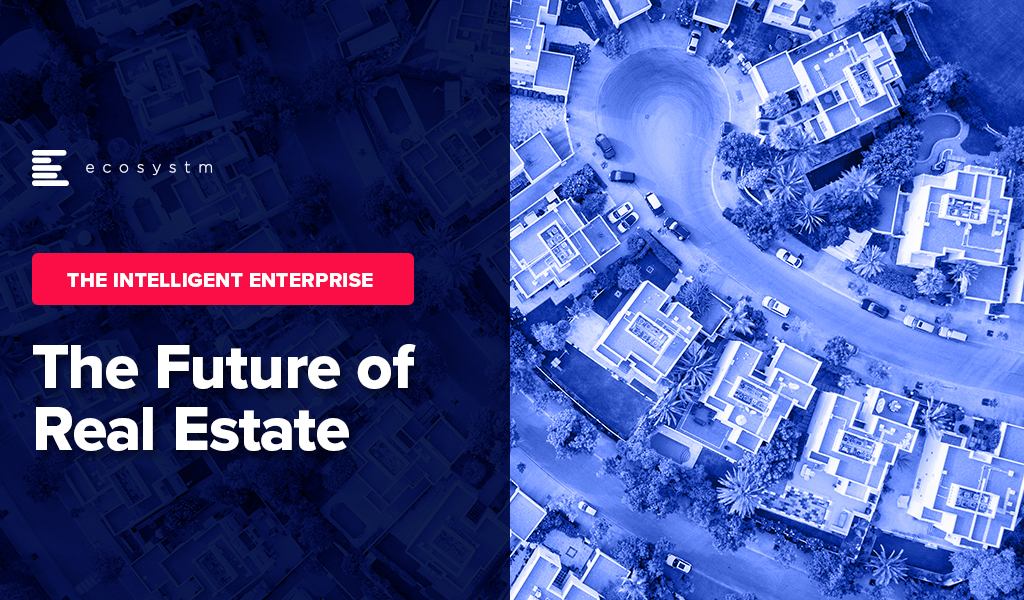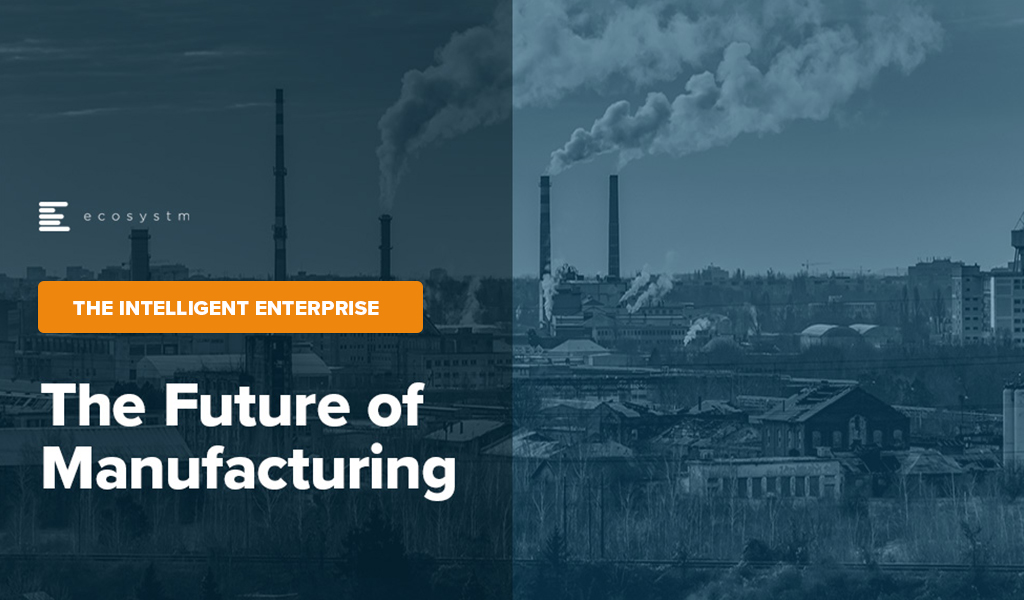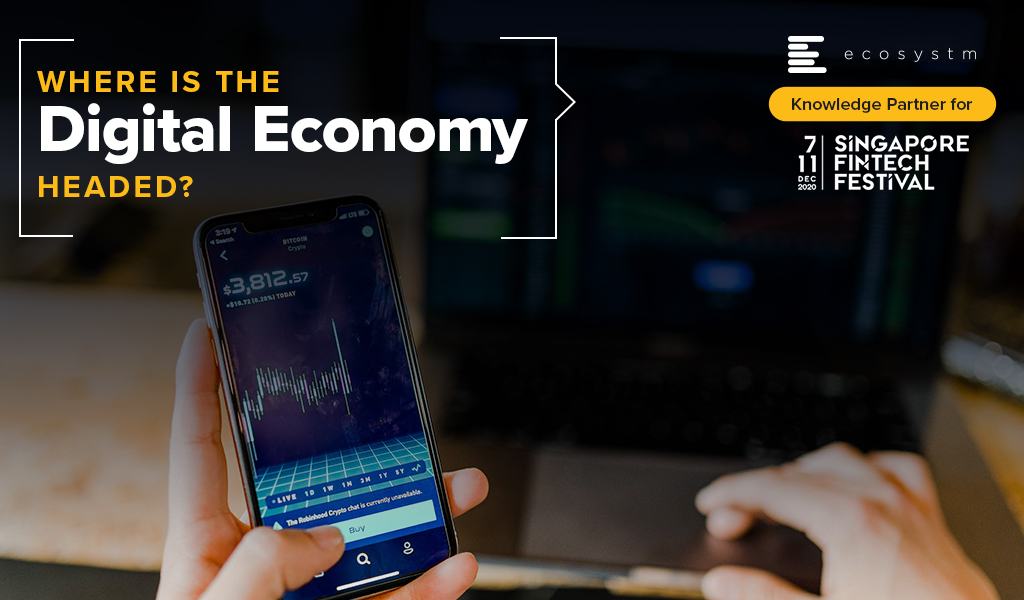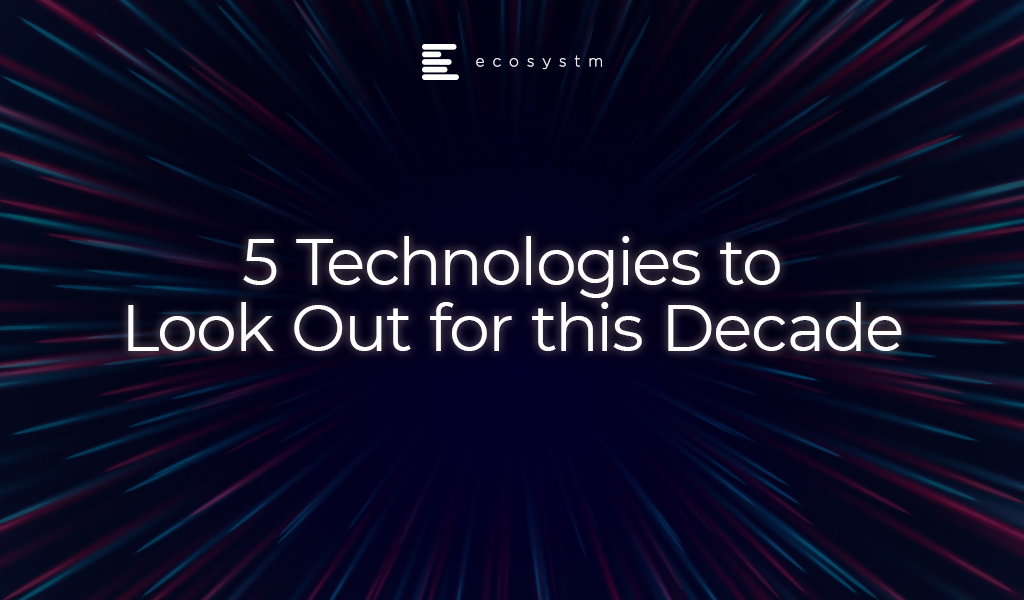Technology has been reshaping the Real Estate industry landscape. Advancements in manufacturing technologies, digital tools, AI & analytics, and IoT – coupled with customer and employee expectations – are revolutionising how properties are built, bought, sold, managed, and experienced.
The evolution of RealTech and PropTech has a far-reaching impact on the industry, streamlining processes, improving customer experiences, and driving innovation across the entire sector.
Read on to find out how technology impacts the entire value chain; the key drivers of Real Estate evolution; the strong influence of “smart consumers”; and what Ecosystm VP Industry Insights Sash Mukherjee thinks where the industry is headed.
Download ‘The Future of Real Estate’ as a PDF

The Manufacturing industry is at crossroads today. It faces challenges such as geopolitical risks, supply chain disruptions, changing regulatory environments, workforce shortages, and changing consumer demands. Overcoming these requires innovation, collaboration, and proactive adaptation.
Fortunately, many of these challenges can be mitigated by technology. The future of Manufacturing will be shaped by advanced technology, automation, and AI. We are seeing early evidence of how smart factories, robotics, and 3D printing are transforming production processes for increased efficiency and customisation.
Manufacturing is all set to become more agile, efficient, and sustainable.
Read on to find out the changing priorities and key trends in Manufacturing; about the World Economic Forum’s Global Lighthouse Network initiative; and where Ecosystm advisor Kaushik Ghatak sees as the Future of Manufacturing.
Click here to download ‘The Future of Manufacturing’ as a PDF

In this blog, our guest authors Randeep Sudan and Yamin Oo talk about the pervasiveness of the Digital Economy, and the key trends that will determine its future trajectory. “That the world in 2030 will be very different from today is obvious. We may, however, be surprised by the extent and sweep of the change ahead of us.”


The Digital Economy – a term first coined by Don Tapscott in 1994 – is not easy to define or measure. At one end, it is limited to the production and consumption of digital goods and services. On the other end, according to the European Parliament, “The digital economy is increasingly interwoven with the physical or offline economy making it more and more difficult to clearly delineate the digital economy“. We are, however, witnessing the Digital Economy transitioning to an economy that is digital.
Given the pervasiveness of the Digital Economy, its future will be determined by the complex interplay of several trends. Some of the trends that illustrate the future trajectory of the Digital Economy are:
Technology
We will see AI becoming ubiquitous as it is leveraged in every sector and sphere of activity. According to one estimate, AI is estimated to contribute USD 15.7 trillion to the global economy by 2030, which is more than the current GDP of China and India combined! We are also likely to see rapid progress in technologies related to Extended Reality (XR) in the coming years. COVID-19 is accelerating this trend, as we can see from the offerings of companies like Spatial and MeetinVR that facilitate virtual business meetings. The analog world’s rendering into its digital twin will see us moving towards a metaverse – a virtual shared space imagined in Neal Stephenson’s novel Snowcrash. Some of the biggest names in the tech industry – Apple (Apple glass), Facebook (Oculus), Sony (Playstation) – are assiduously working towards this direction.
Given the importance of telecom infrastructure to the Digital Economy, 5G networks are being rolled out in countries worldwide (Figure 1). However, even as 5G is being deployed, the buzz around 6G is getting louder. 6G may transmit data 100 times faster than 5G and may see deployment by 2030 given the decadal cycles for telecom: 1G in the 80s, 2G in the 90s, 3G in the decade following 2000, 4G in the decade starting 2010, and 5G beginning in the 2020s.
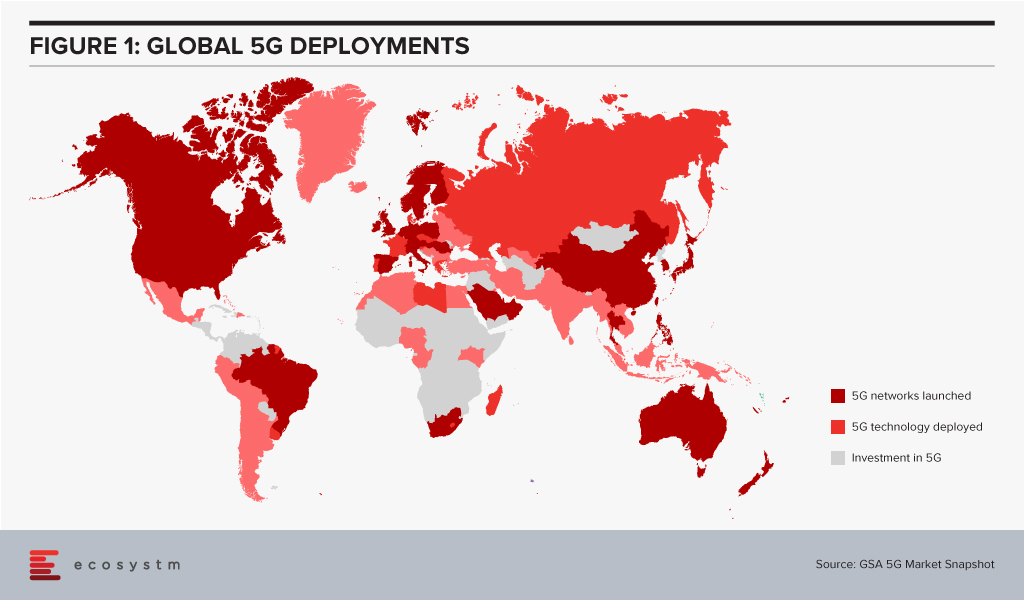
The availability of high bandwidth, low latency networks could lead to newer applications and further breakthroughs in innovative technologies.
The Future of Work
With the rapid growth in automation and AI, we are likely to see significant labour market disruptions. Moreover, COVID-19 has been a watershed for the global economy – its impacts will continue to be felt for many years to come. According to the International Labor Organization, 495 million full-time jobs were lost in the first two quarters of 2020 due to COVID-19. Lower and middle-income countries have suffered the most, with an estimated 23.3% drop in working hours – equivalent to 240 million jobs.
A recent report from the World Economic Forum estimates that by 2025, 85 million jobs may be displaced due to automation and AI, while 97 million new roles may emerge. We will see significant changes and turbulence in labour markets across multiple industries and geographies in the years ahead. If we look at how the top ten skills required by the top 10 US companies have been changing over time, we get an indication of the Future of Work. Companies are more focused on “soft” skills, that are not easily addressed by AI & Automation.
We are also likely to see a shift from humans adapting to technology to technologies adapting to humans. For example, the acceleration in digital twins combined with advancements in XR could allow unskilled workers to do skilled jobs. AR could guide a worker to repair a piece of mechanical equipment without long years of previous training. Similarly, the emergence of ‘Low Code No Code’ (LCNC) applications will allow ordinary individuals to do tasks that previously required specialised training.
Climate Change
Scientists have long focused our attention to limit the carbon dioxide in the atmosphere to 450 parts per million to avoid catastrophic climate change. In 2016, the World Meteorological Organization reported this concentration had crossed 400 parts per million, leaving us with a shorter runway to prevent calamitous climate change. We are, therefore, likely to see increased efforts to tackle climate change in the decade ahead.
Digital technologies can impact the global climate agenda in multiple ways: smart grids, smart buildings, smart appliances, intelligent transport systems, shared mobility, and 3D printing, to name a few. Digital technologies will also allow new sources of renewable energy to be tapped. For example, the molten core of the earth is over 6,000°C. “Just 0.1% of the heat content of Earth could supply humanity’s total energy needs for 2 million years,” according to AltaRock Energy. Advances in the use of digital technologies that allow for precise directional drilling will allow for advanced geothermal systems to be established as reliable power sources.
Splinternet
Tech bloggers like Doc Searls and Stephen Lewis had begun to theorise about a Splinternet as early as 2008. There was a danger of governments carving the world into geopolitical blocks and creating technology barriers. China’s Great Firewall and the US’s recent responses under the Trump administration are likely to hurtle us in the direction of a fractured internet. We may end up with the US dominating the western internet and China dominating a competing block of countries. The Digital Economy’s evolution would fracture into different camps, making it very different from what it is today.
Tech Regulation
The most valuable companies in the world today are in tech. Seven of the top ten companies in the world by market cap in 2020 are tech companies.
The recent investigation into competition in digital markets undertaken by the US House Judiciary Committee observed: “Over the past decade, the digital economy has become highly concentrated and prone to monopolisation. Several markets investigated by the Subcommittee – such as social networking, general online search, and online advertising – are dominated by just one or two firms. The companies investigated by the Subcommittee – Amazon, Apple, Facebook, and Google – have captured control over key channels of distribution and have come to function as gatekeepers. Just a decade into the future, 30% of the world’s gross economic output may lie with these firms, and just a handful of others.“
We have also witnessed the rapid diversification of data monopolies into other sectors. See, for example, the diversification of VC investments by Alibaba’s Ant Group over time. In 2015 they were investing in 5 areas, which has doubled in the last 5 years.
The call for the regulation of big tech will gain momentum in the coming years. The European Union is likely to lead here, just the way just it did in the case of its General Data Protection Regulation.
Governments will also require data monopolies to share data. China mandates its automakers to share data generated by electric vehicles with a government research institute. This data is essential for public safety and planning battery-recharging stations. The Australian Government promotes the concept of sharing “designated datasets” that could include data held by the private sector that has significant community benefits. Similarly, France’s Law for a Digital Republic requires the sharing data by certain categories of the private sector. Such blurring of boundaries between public and private data will become more important.
We will also see the growing importance of data trusts. These are structures where data is placed in the custody of a “Board of Trustees” who have a fiduciary responsibility to look after the interests of data owners. Such data trusts might give individuals better control over their data.
Every aspect of the economy is being digitalised today. In the next decade we are likely to witness foundational shifts in how the Digital or Data Economy is structured. It will also see increasing risks as cyber threats grow exponentially from cybercriminals and state actors. That the world in 2030 will be very different from today is obvious. We may, however, be surprised by the extent and sweep of the change ahead of us.
Singapore FinTech Festival 2020: Economic Summit
For more insights, attend the Singapore FinTech Festival 2020: Economic Summit which will cover topics tied to the state of the economy, path to recovery and re-framing the new financial services landscape

We can safely bet that in the decade taking us to 2030, technology will continue to impact and shape our world. Ecosystm has already predicted the top technology trends for 2020 (AI, Cloud, Cybersecurity, IoT). It is time to look beyond the year and see what 2030 has in store for us. There is a distinct possibility that there will be newer technologies in future that we are yet to hear of, waiting at the threshold to disrupt the existing tech space. Also by 2030, there will be many technologies that are considered futuristic today that will have become mainstream. Let us explore some of them.
Computing Technology
Quantum computing has been promising to take computing beyond current limits – going beyond bits to qubits. Qubits represent atoms, ions, photons or electrons and their respective control devices that are working together to act as computer memory and processor. It has the potential to process exponentially more data than current computers.
Even with various technology providers such as Google, IBM, AWS and Microsoft having announced their quantum computing innovations, it does not appear to be nearly enough to disrupt computing yet. The race to demonstrate the first usable quantum computer is on and start-ups such as Rigetti are challenging the established players. Whether or not the vision we have of quantum computers is fully realised, it will definitely bring in a new breed of computers with advanced processors capable of handling data, million times faster than today’s supercomputers.
Technology providers and government research organisations will continue the R&D initiatives to meet quantum’s real-world potential. Over the next decade, quantum computing applications are set to impact scientific research and exploration, including space exploration and materials science. Quantum computing will also impact us in our everyday lives enabling better weather forecasting and personalised healthcare.
Storage Technologies
Cloud storage has dominated most of the previous decade, enabling real-time access to data for both consumers and enterprises. The current storage technologies are reaching the verge of their theoretical storage capacity, given the amount of data we generate. Researchers continue to push the envelope when it comes to capacity, performance, and the reduction of the physical size of storage media. Some storage technologies of the future that have the potential to become mainstream are:
DNA Data storage
DNA stores the ‘data’ for every living organism and one day it could be the ultimate hard drive! DNA data storage consists of long chains of the nucleotides A, T, C and G – which are the building blocks of our DNA chains. DNA storage and computing systems use liquids to move molecules around, unlike electrons in silicon-based systems. This enables the stored data to be more secure and potentially allows an almost infinite storage lifespan. Researchers from Microsoft and the University of Washington have demonstrated the first fully automated system to store and retrieve data in manufactured DNA – a key step in taking the technology out of the realms of theory and into reality. The technology is still too expensive and requires new engineering solutions for it to be viable in the near future. However, there are several research organisations and start-ups out there working on creating synthetic DNA – data storage is seen as one of the many applications of the technology.
Glass Data storage
5D Glass Discs are being researched and experts say that they could store 3000x more data than CDs with a span of 13.8 billion years. The discs are made out of nanostructured glass, and the data is stored and retrieved using femtosecond laser writing. The discs are made by a laser that makes microscopic etchings in nano glass. The University of Southampton has developed the highest storage efficiency in a data storage device to date. Microsoft’s Project Silica has developed a proof of concept for its quartz glass storage in partnership with Warner Bros, storing the 1978 classic movie, Superman on a palm-size glass disc.
Nanotechnology
Nanotechnology is the science of understanding and manipulating materials on a nanometre scale. It has the potential to create the ultimate IoT sensors. Nanotechnology is already being used in the production of some microprocessors, batteries, computer displays, paints and cosmetics. But this really is just the beginning of a nano revolution.
The most researched nanotechnology applications are probably in medical science. By injecting or implanting tiny sensors, detailed information can be gathered about the human body. Innovations in implantable nanotechnology will grow and we will see more applications and innovations such as Smart Dust – a string of smart computers each smaller than a grain of sand. They can arrange themselves in nests in specified body locations for diagnostics or cure. The focus is not only on early detection but also on storing encrypted patient information. MIT is working on a nanotechnology application which involves nanoparticles or tiny robots powered by magnetic fields for targeted drug delivery.
Healthcare is not the only industry where nanotechnology will become mainstream. Materials science will see huge adoption and development of nanotechnology applications, this will drive innovation even in wearable devices and smart clothing. Nanomaterials will be used for monitoring in manufacturing, power plants, aircrafts and so on.
Printing Technologies
Astonishingly, it has been nearly 40 years since 3D printing technology was conceptualised. In the last few years, there has been rapid adoption in prototyping using 3D printers in manufacturing and construction. There has also been considerable research applications such as printing food and replacement organs. For example, companies have already demonstrated that they can create 3D prototypes of human liver tissue patches and implant them in mice.
4D printing will be the next step. With 4D printing, we can change shapes of 3D-printed objects upon stimuli from specific environmental conditions, such as temperature, light or humidity. Although the 4D printing technology is still in the R&D phase, this technology of the future has huge implications in the applications of engineering, manufacturing and construction. For instance, 4D printed bricks could change shape and size when placed alongside other bricks on the wall giving us better insights on how to protect property from natural disasters.
Connectivity Technologies
The world is becoming increasingly connected. Access to fast and reliable Internet is one of the many reasons for economic and social progress. There is constant R&D on a more seamless connectivity option. Industry giants are coming up with solutions to connect people in remote areas – such as providing emergency connectivity through helium balloons. Facebook’s Internet.org intends to provide universal connectivity using drones, low-Earth orbit and geosynchronous satellites. It is easy to predict that in 2030 everyone will have connectivity. While we are discussing the full impact of 5G, China’s Ministry of Science and Technology has already announced that they are embarking on R&D on 6G – more suited to a world where IoT becomes mainstream.
Li-Fi Technology
Li-Fi technology (Light Fidelity) works on visible light communications which sends data at a much higher speed. As we look for lower latency and higher speed, Li-Fi may very well be the technology that becomes mainstream in 2030. It is a wireless optical networking technology that uses LEDs for data transmission. In the lab, Li-Fi applications have reached transfer speeds of 10 Gbps, faster than the Wi-Fi 6 router. Li-Fi is being pegged as the network technology that will finally enable the true Edge. The recent Aircraft Interiors Expo (AIX) showcased a Li-Fi application that supported 40 Mbps transmissions and streamed HD content from a visible passenger service unit (PSU).
Ecosystm will continue to scan the horizon for newer technologies that can potentially disrupt the already disruptive tech world.
What do you think are the technologies of the future that will shape our lives in this decade? Tell us in your comments.


